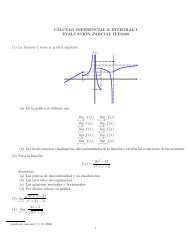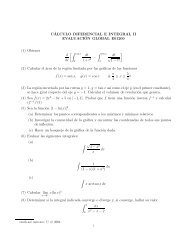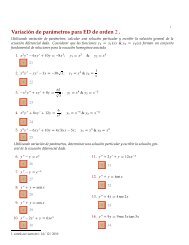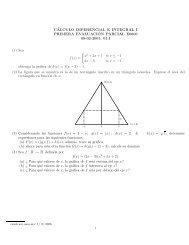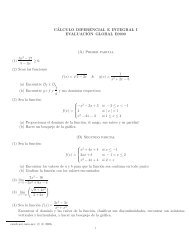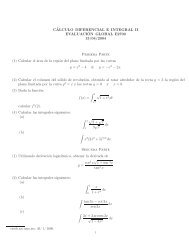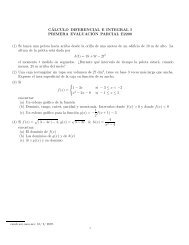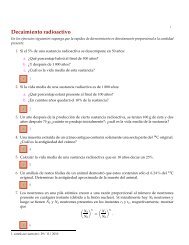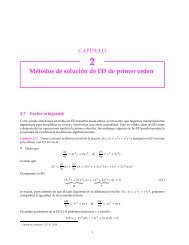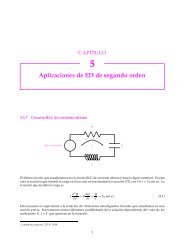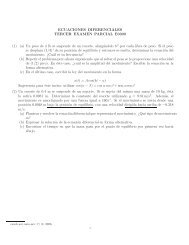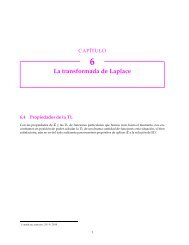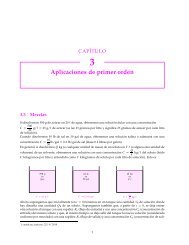Ecuaciones diferenciales de orden superior - Canek - UAM
Ecuaciones diferenciales de orden superior - Canek - UAM
Ecuaciones diferenciales de orden superior - Canek - UAM
You also want an ePaper? Increase the reach of your titles
YUMPU automatically turns print PDFs into web optimized ePapers that Google loves.
8 <strong>Ecuaciones</strong> <strong>diferenciales</strong> ordinarias<br />
Integrando:<br />
u1 D<br />
Utilizando el cambio <strong>de</strong> variable t D 1 C e x :<br />
<br />
e2x 1 C ex dx & u2<br />
<br />
D<br />
u1 D ln.1 C e x / .1 C e x / C C1:<br />
u2 D ln.1 C e x / C C2:<br />
ex dx:<br />
1 C ex Tomando u1 D ln.1 C e x / .1 C e x / & u2 D ln.1 C e x /, se obtiene la solución particular<br />
yp D u1e x C u2e 2x D Œln.1 C e x / .1 C e x /e x C Œln.1 C e x /e 2x D<br />
D e x ln.1 C e x / C e 2x ln.1 C e x / e x .1 C e x / D Œe x ln.1 C e x /Œ1 C e x e x .1 C e x / )<br />
) yp.x/ D e x .1 C e x /Œln.1 C e x / 1:<br />
Por lo tanto, la solución general <strong>de</strong> la ED es<br />
y D yp.x/ C c1y1.x/ C c2y2.x/ ) y D e x .1 C e x /Œln.1 C e x / 1 C c1e x C c2e 2x :<br />
De acuerdo a lo discutido en esta sección, una solución particular yp <strong>de</strong> la ED lineal normalizada<br />
tiene la forma:<br />
y 00 C p.x/y 0 C q.x/y D g.x/<br />
yp.x/ D u1 1.x/ C u2 2.x/;<br />
don<strong>de</strong> f 1.x/; 2.x/ g es un conjunto fundamental <strong>de</strong> soluciones <strong>de</strong> la ED homogénea asociada:<br />
y 00 C p.x/y 0 C q.x/y D 0I<br />
y las funciones u1 & u2 se obtienen integrando, respectivamente, las funciones u 0 1 & u 0 2<br />
<strong>de</strong>l sistema ˚<br />
1u 0 1 C 2u 0 2 D 0I<br />
0<br />
1u 0 1 C 0 2u 0 2 D g.x/I<br />
el cual resolvemos por el método <strong>de</strong> Cramer. Aún más:<br />
u 0 1<br />
D W1<br />
W<br />
& u 0 2<br />
D W2<br />
W ;<br />
que son soluciones<br />
don<strong>de</strong> W D W Π1.x/; 2.x/ 6D 0 [para toda x en el intervalo don<strong>de</strong> p.x/ & q.x/ sean continuas] y W1<br />
& W2 están dadas mediante un <strong>de</strong>terminante en el que se sustituye la columna 1 & 2, respectivamente, <strong>de</strong><br />
W por la columna:<br />
<br />
0<br />
:<br />
g.x/<br />
Es conveniente señalar las fortalezas y <strong>de</strong>bilida<strong>de</strong>s <strong>de</strong> este método en comparación con el método <strong>de</strong> coeficientes<br />
in<strong>de</strong>terminados, tratado en la sección anterior.<br />
1. El método <strong>de</strong> coeficientes in<strong>de</strong>terminados es en muchos casos más sencillo y fácil <strong>de</strong> aplicar que el<br />
<strong>de</strong> variación <strong>de</strong> parámetros, pero tiene esta limitación: sólo es aplicable cuando g.x/ tiene la forma<br />
<strong>de</strong> un polinomio, exponencial, combinación lineal <strong>de</strong> senos y cosenos o una suma <strong>de</strong> las funciones<br />
mencionadas. A<strong>de</strong>más la ED lineal <strong>de</strong>be tener coeficientes constantes.



